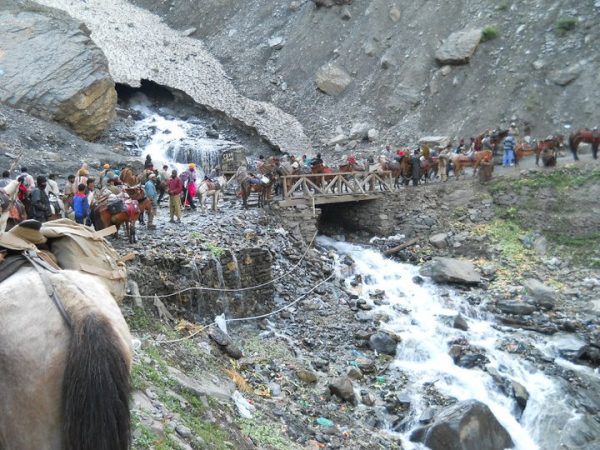
On July 8, tragedy struck the Amarnath yatra (pilgrimage). At least 35 Hindu pilgrims on their way to the Amarnath shrine were killed and dozens of others went missing after flash floods caused landslides near the Baltal base camp in Ganderbal district in Jammu and Kashmir.
Survivors of the floods told The Diplomat that they were going about their daily routine and resting in the evening when they heard the sound of water gushing toward them; the sound of water was growing louder by the second, they recalled. Many ran out of their tents and managed to escape. However, those who couldn’t were swallowed by the icy waters.
The flash floods were reportedly caused by a “highly localized rain event,” according to the Indian Meteorological Department. However, the role of unsustainable human presence in the area on account of the annual pilgrimage cannot be ignored. Rising foot traffic due to government-promoted religious tourism has left the hillsides vulnerable to landslides during downpours.
The annual 43-day Amarnath yatra commenced this year on June 30. Since then tens of thousands of pilgrims have been trekking to the Amarnath cave.
This year’s pilgrimage was the first in three years. In 2019, the yatra was cut short ahead of the Narendra Modi government’s controversial decision on August 5 revoking Jammu and Kashmir’s autonomy, in anticipation of public unrest. The COVID-19 pandemic resulted in the cancellation of yatras in 2020 and 2021.
Located at an altitude of 3,657 meters, the Amarnath shrine is a cave in Batakote in Pahalgam, nestled amid snow-clad peaks and glaciers. The cave is home to a stalagmite that Hindus worship as a lingam, symbolic of the Hindu deity Shiva.
The cave was discovered in 1850 by a Muslim shepherd and since then, Hindu pilgrims have made their way to the Amarnath shrine every year during summer.
Following the tragedy, the government suspended the pilgrimage. Two days later, however, the yatra was resumed and thousands of pilgrims were trekking again to the high-altitude shrine.
At a minimum, the J&K administration should have restricted the number of people heading out on the rain-washed routes in the mountains. Instead, J&K’s Lieutenant Governor Manoj Sinha announced that the Shri Amarnathji Shrine Board (SASB), which he heads, had decided to increase the number of people embarking on the pilgrimage from 15,000 to 20,000 per day.
In so doing, the SASB and the J&K administration have violated a 2012 ruling by India’s Supreme Court under which the number of pilgrims heading to the Amarnath cave was capped at 15,000 (7,500 through each of the two routes).
While faith motivates many of those who undertake the arduous journey to the Amarnath shrine, the government has been promoting the yatra as religious tourism.
This has come in for criticism from some religious leaders. During his recent visit to J&K, the Shankaracharya, a respected Hindu seer, condemned the J&K administration’s marketing of the Amarnath yatra as “religious tourism.” “The journey to Shri Amarnath is a journey of religion and faith. It is beneficial to walk it with faith,” he said.
Reacting to the July 8 landslide tragedy, the Shankaracharya drew attention to pressures on the environment that even a temporary increase in population has. “If nature is exploited, then it is natural to have an adverse effect,” the seer observed, condemning the “industrialization” of the region where the Amarnath shrine is located.
Studies point to multiple pressures on the environment along the Amarnath yatra route. Citing a study on municipal solid waste generation during the yatra season, an article in The Wire Science says that an estimated 1,000 tonnes of garbage will be generated during the yatra this year. The article also draws attention to an environmental impact assessment of the Lidder Valley carried out by Kashmir University experts a few years ago, which found that the carrying capacity in the area is only 4,300 people per day. However, an average of 12,353 pilgrims are reported to have visited the cave each day during the first 25 days of the pilgrimage in the sample year of 2019.
The Amarnath yatra has a long history of tragedies, both natural and man-made. Militants have targeted the pilgrims several times in recent decades. In August 2000, for instance, the Hizbul Mujahideen killed over 20 Amarnath pilgrims at the Nunwan base camp in Pahalgam. Inclement weather conditions resulted in the death of 250 pilgrims in 1996.
The recent flash flood, the third since 2015, is clearly the outcome of unsustainable human presence in an extremely fragile terrain. Viewing the death toll, on July 23, officials suspended the pilgrimage from Jammu due to due extreme weather and conditions on Jammu-Srinagar national highway. No fresh batch was allowed to proceed from here to the base camps of the shrine.
The Amarnath yatra symbolizes Hindu-Muslim unity. While this is essentially a pilgrimage for Hindus, Muslims enable it by providing logistical support to the pilgrims. They provide ponies and palanquins for those who cannot walk to the shrine, provide tenting accommodation, and run food stalls along the route.
However, the government’s move to push up the numbers trekking up to the cave and pressing ahead with the yatra despite the threat of environmental disasters shows that this is not a pilgrimage motivated by faith and spirituality anymore. Analysts say that the government’s aggressive marketing of the Amarnath yatra after a three-year ban on the pilgrimage signals the BJP’s desperation to consolidate support among Hindus.
The Amarnath yatra is being deployed by the Modi government as a tool to promote Hindu nationalism. By repackaging the yatra as an event that is happening on a huge scale after three years, the BJP is presenting itself as the custodian of the interests of not just Hindus but of all Kashmiris.
As humans continue to exhaust nature and its resources, nature has its own way of deciding the course of events.
Despite Disaster, 35 Deaths, Hindu Religious Pilgrimage in Kashmir Continues
Source: Frappler

0 Comments